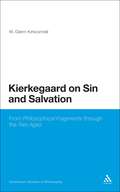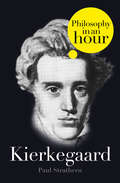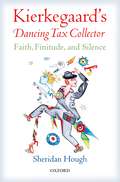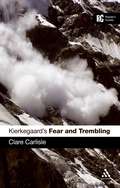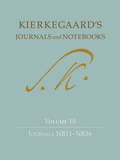- Table View
- List View
Kierkegaard on Ethics and Religion: From Either/Or to Philosophical Fragments (Continuum Studies in Philosophy)
by W. Glenn KirkconnellSøren Kierkegaard is simultaneously one of the most obscure philosophers of the Western world and one of the most influential. His writings have influenced atheists and faithful alike. Yet there is still widespread disagreement on many of the most important aspects of his thought. Kierkegaard was deliberately obscure in his writings, forcing the reader to interpret and reflect as Socrates did with incessant questioning. But at the same time that Kierkegaard was producing his esoteric, pseudonymous philosophical writings, he was also producing simpler, direct religious writings. Kierkegaard always claimed that he was, despite appearances, a religious writer. This important book accepts that claim and tests it. By using Kierkegaard's direct writings as he suggests, as the key to understanding the more obscure, indirect works, W. Glenn Kirkconnell aims to develop a coherent understanding of Kierkegaard's authorship and his theories.
Kierkegaard on Politics
by Barry StockerThis investigation of Kierkegaard as a political thinker with regard to the Danish context, and to his place in the history of political thought, deals with the more direct discussion of politics in Kierkegaard, and the ways in which political ideas are embedded in his literary, aesthetic, ethical, philosophical ,and religious thought.
Kierkegaard on Sin and Salvation: From Philosophical Fragments through the Two Ages (Continuum Studies in Philosophy)
by W. Glenn KirkconnellSøren Kierkegaard (1813-1855) is simultaneously one of the most obscure philosophers of the Western world and one of the most influential. His writings have influenced atheists and faithful alike. Yet despite his now pervasive influence, there is still widespread disagreement on many of the most important aspects of his thought. Kierkegaard was deliberately obscure in his philosophical writings, forcing his reader to interpret and reflect. But at the same time that Kierkegaard produced his esoteric, pseudonymous philosophical writings, he was also producing simpler, direct religious writings. Since his death the connections between these two sets of writings have been debated, ignored or denied by commentators. Here W. Glenn Kirkconnell undertakes a thorough examination of the two halves of Kierkegaard's authorship, demonstrating their ethical and religious relationship and the unifying themes of the signed and pseudonymous works. In particular the book examines Kierkegaard's understanding of the fall of the self and its recovery and the implications of his entire corpus for the life of the individual.
Kierkegaard on the Philosophy of History
by G. PatiosHistory doesn't have to mean only an effort to know the past. It can be instead, according to Kierkegaard, a willful and personal choice regarding the creation of the future. Kierkegaard offers us an amazing new approach to the problem of what is history and who makes it.
Kierkegaard: Philosophy in an Hour
by Paul StrathernPhilosophy for busy people. Read a succinct account of the philosophy of Kierkegaard in just one hour.
Kierkegaard, Pietism and Holiness (Routledge New Critical Thinking in Religion, Theology and Biblical Studies)
by Christopher B. BarnettSøren Kierkegaard wrote that Pietism is 'the one and only consequence of Christianity'. Praise of this sort - particularly when coupled with Kierkegaard's significant personal connections to the movement in Christian spirituality known as Pietism - would seem to demand thorough investigation. And yet, Kierkegaard's relation to Pietism has been largely neglected in the secondary literature. Kierkegaard, Pietism and Holiness fills this scholarly gap and, in doing so, provides the first full-length study of Kierkegaard's relation to the Pietist movement. First accounting for Pietism's role in Kierkegaard's social, ecclesial, and intellectual background, Barnett goes on to demonstrate Pietism's impact on Kierkegaard's published authorship, principally regarding the relationship between Christian holiness and secular culture. This book not only establishes Pietism as a formative influence on Kierkegaard's life and thinking, but also sheds fresh light on crucial Kierkegaardian concepts, from the importance of 'upbuilding' to the imitation of Christ.
Kierkegaard, Pietism and Holiness (Routledge New Critical Thinking in Religion, Theology and Biblical Studies)
by Christopher B. BarnettSøren Kierkegaard wrote that Pietism is 'the one and only consequence of Christianity'. Praise of this sort - particularly when coupled with Kierkegaard's significant personal connections to the movement in Christian spirituality known as Pietism - would seem to demand thorough investigation. And yet, Kierkegaard's relation to Pietism has been largely neglected in the secondary literature. Kierkegaard, Pietism and Holiness fills this scholarly gap and, in doing so, provides the first full-length study of Kierkegaard's relation to the Pietist movement. First accounting for Pietism's role in Kierkegaard's social, ecclesial, and intellectual background, Barnett goes on to demonstrate Pietism's impact on Kierkegaard's published authorship, principally regarding the relationship between Christian holiness and secular culture. This book not only establishes Pietism as a formative influence on Kierkegaard's life and thinking, but also sheds fresh light on crucial Kierkegaardian concepts, from the importance of 'upbuilding' to the imitation of Christ.
Kierkegaard: The Self in Society
by Steven ShakespeareKierkegaard: The Self in Society brings together scholars from a variety of disciplines to explore Kierkegaard's continuing relevance to political and social issues. Kierkegaard is often portrayed as an out-and-out individualist with no concern for interpersonal relations. These essays not only refute this caricature, they bring out the complex nature of Kierkegaard's engagements with questions of selfhood and society. What Kierkegaard has to say about love, the church, politics and justice is shown to test the limits of what we take for granted in the modern (and postmodern) world.
The Kierkegaardian Mind (Routledge Philosophical Minds)
by Adam Buben Patrick Stokes Eleanor HelmsSøren Kierkegaard (1813-1855) remains one of the most enigmatic, captivating, and elusive thinkers in the history of European thought. The Kierkegaardian Mind provides a comprehensive survey of his work, not only placing it in its historical context but also exploring its contemporary significance. Comprising thirty-eight chapters by a team of international contributors, this handbook is divided into eight parts covering the following themes: Methodology Ethics Aesthetics Philosophy of Religion and Theology Philosophy of Mind Anthropology Epistemology Politics. Essential reading for students and researchers in philosophy, Kierkegaard’s work is central to the study of political philosophy, literature, existentialist thought, and theology.
The Kierkegaardian Mind (Routledge Philosophical Minds)
by Adam Buben Patrick Stokes Eleanor HelmsSøren Kierkegaard (1813-1855) remains one of the most enigmatic, captivating, and elusive thinkers in the history of European thought. The Kierkegaardian Mind provides a comprehensive survey of his work, not only placing it in its historical context but also exploring its contemporary significance. Comprising thirty-eight chapters by a team of international contributors, this handbook is divided into eight parts covering the following themes: Methodology Ethics Aesthetics Philosophy of Religion and Theology Philosophy of Mind Anthropology Epistemology Politics. Essential reading for students and researchers in philosophy, Kierkegaard’s work is central to the study of political philosophy, literature, existentialist thought, and theology.
Kierkegaard's Analysis of Radical Evil (Continuum Studies in Philosophy)
by David A. RobertsFor thousands of years philosophers and theologians have grappled with the problem of evil. Traditionally, evil has been seen as a weakness of sorts: the evil person is either ignorant, or weak-willed. But in the most horrifying acts of evil, the perpetrators are resolute, deliberate, and well aware of the pain they are causing. Here David Roberts painstakingly details the matrix of issues that evolved into Kierkegaard's own solution. Kierkegaard's psychological understanding of evil is that it arises out of despair - a despair that can become so vehement and ferocious that it lashes out at existence itself. Roberts shows how the despairing self can become strengthened and intensified through a conscious and free choice against the Good. This type of radical evil is neither ignorant nor weak.
Kierkegaard's and Heidegger's Analysis of Existence and its Relation to Proclamation (Selected Works of K.E. Logstrup)
by K. E. LøgstrupThe great Danish philosopher and theologian K. E. Løgstrup (1905-81) offers a distinctive assessment and comparative critique of two key thinkers in Kierkegaard's and Heidegger's Analysis of Existence and its Relation to Proclamation (1950). Løgstrup focuses on the central idea from Kierkegaard and Heidegger that our individuality and authenticity are threatened by 'life in the crowd' or 'das Man'. According to Løgstrup, Kierkegaard holds that the only way to escape the crowd is through a relation to an infinite demand which he nonetheless leaves empty, while Heidegger avoids offering any kind of ethics at all. Arguing against both philosophers, Løgstrup himself proposes an ethic which is not just a set of social rules, but which is also more contentful than Kierkegaard's infinite demand: namely, the requirement to care for the other person whose life is placed in your hands. This call to care for the other person becomes central to Løgstrup's position in his most famous publication The Ethical Demand (1956), so this earlier work, based on lectures given in Berlin, provides a crucial insight into the development of his thought. This is the first English translation of an original and compelling text by Løgstrup, rendered into accurate prose and paired with an introduction which explains the main themes and wider context of the work.
Kierkegaard's and Heidegger's Analysis of Existence and its Relation to Proclamation (Selected Works of K.E. Logstrup)
by K. E. LøgstrupThe great Danish philosopher and theologian K. E. Løgstrup (1905-81) offers a distinctive assessment and comparative critique of two key thinkers in Kierkegaard's and Heidegger's Analysis of Existence and its Relation to Proclamation (1950). Løgstrup focuses on the central idea from Kierkegaard and Heidegger that our individuality and authenticity are threatened by 'life in the crowd' or 'das Man'. According to Løgstrup, Kierkegaard holds that the only way to escape the crowd is through a relation to an infinite demand which he nonetheless leaves empty, while Heidegger avoids offering any kind of ethics at all. Arguing against both philosophers, Løgstrup himself proposes an ethic which is not just a set of social rules, but which is also more contentful than Kierkegaard's infinite demand: namely, the requirement to care for the other person whose life is placed in your hands. This call to care for the other person becomes central to Løgstrup's position in his most famous publication The Ethical Demand (1956), so this earlier work, based on lectures given in Berlin, provides a crucial insight into the development of his thought. This is the first English translation of an original and compelling text by Løgstrup, rendered into accurate prose and paired with an introduction which explains the main themes and wider context of the work.
Kierkegaard's Authorship: A Guide to the Writings of Kierkegaard (Routledge Revivals)
by George E. Arbaugh George B. ArbaughFirst published in English in 1968, Kierkegaard's Authorship begins with a brief account of the life and meaning of Kierkegaard and concludes with the brief treatment of his relation to multifaceted existentialism. By reviewing the total authorship and by making available much of the fruit of widespread research, this work throws into relief Kierkegaard’s central purposes and makes it possible to avoid some of the dubious interpretations which have grown out of more narrowly selective study. This critical introduction and guide is especially important because Kierkegaard’s style was deliberately indirect and distorted and even more because half of the works are actually antagonistic to Kierkegaard’s own views. By the pseudonymous works he intended to lead into truth through a process of frustration, provoking the reader into existence. In another sense, the body of the book is also a biography for, in a degree perhaps without parallel in world history, the library which he created was his deed and life. This is an important read for scholars and researchers of Philosophy specially existentialism.
Kierkegaard's Authorship: A Guide to the Writings of Kierkegaard (Routledge Revivals)
by George E. Arbaugh George B. ArbaughFirst published in English in 1968, Kierkegaard's Authorship begins with a brief account of the life and meaning of Kierkegaard and concludes with the brief treatment of his relation to multifaceted existentialism. By reviewing the total authorship and by making available much of the fruit of widespread research, this work throws into relief Kierkegaard’s central purposes and makes it possible to avoid some of the dubious interpretations which have grown out of more narrowly selective study. This critical introduction and guide is especially important because Kierkegaard’s style was deliberately indirect and distorted and even more because half of the works are actually antagonistic to Kierkegaard’s own views. By the pseudonymous works he intended to lead into truth through a process of frustration, provoking the reader into existence. In another sense, the body of the book is also a biography for, in a degree perhaps without parallel in world history, the library which he created was his deed and life. This is an important read for scholars and researchers of Philosophy specially existentialism.
Kierkegaard's Concept of Despair (Princeton Monographs in Philosophy #49)
by Michael TheunissenThe literature on Kierkegaard is often content to paraphrase. By contrast, Michael Theunissen articulates one of Kierkegaard's central ideas, his theory of despair, in a detailed and comprehensible manner and confronts it with alternatives. Understanding what Kierkegaard wrote on despair is vital not only because it illuminates his thought as a whole, but because his account of despair in The Sickness unto Death is the cornerstone of existentialism. Theunissen's book, published in German in 1993, is widely regarded as the best treatment of the subject in any language. Kierkegaard's Concept of Despair is also one of the few works on Kierkegaard that bridge the gap between the Continental and analytic traditions in philosophy. Theunissen argues that for Kierkegaard, the fundamental characteristic of despair is the desire of the self "not to be what it is." He sorts through the apparently chaotic text of The Sickness unto Death to explain what Kierkegaard meant by the "self," how and why individuals want to flee their selves, and how he believed they could reconnect with their selves. According to Theunissen, Kierkegaard thought that individuals in despair seek to deny their authentic selves to flee particular aspects of their character, their past, or the world, or in order to deny their "mission." In addition to articulating and evaluating Kierkegaard's concept of despair, Theunissen relates Kierkegaard's ideas to those of Heidegger, Sartre, and other twentieth-century philosophers.
Kierkegaard's Concept of Despair (Princeton Monographs in Philosophy #49)
by Michael TheunissenThe literature on Kierkegaard is often content to paraphrase. By contrast, Michael Theunissen articulates one of Kierkegaard's central ideas, his theory of despair, in a detailed and comprehensible manner and confronts it with alternatives. Understanding what Kierkegaard wrote on despair is vital not only because it illuminates his thought as a whole, but because his account of despair in The Sickness unto Death is the cornerstone of existentialism. Theunissen's book, published in German in 1993, is widely regarded as the best treatment of the subject in any language. Kierkegaard's Concept of Despair is also one of the few works on Kierkegaard that bridge the gap between the Continental and analytic traditions in philosophy. Theunissen argues that for Kierkegaard, the fundamental characteristic of despair is the desire of the self "not to be what it is." He sorts through the apparently chaotic text of The Sickness unto Death to explain what Kierkegaard meant by the "self," how and why individuals want to flee their selves, and how he believed they could reconnect with their selves. According to Theunissen, Kierkegaard thought that individuals in despair seek to deny their authentic selves to flee particular aspects of their character, their past, or the world, or in order to deny their "mission." In addition to articulating and evaluating Kierkegaard's concept of despair, Theunissen relates Kierkegaard's ideas to those of Heidegger, Sartre, and other twentieth-century philosophers.
Kierkegaard's Concept of Despair
by Michael Theunissen Barbara Harshav Helmut IllbruckThe literature on Kierkegaard is often content to paraphrase. By contrast, Michael Theunissen articulates one of Kierkegaard's central ideas, his theory of despair, in a detailed and comprehensible manner and confronts it with alternatives. Understanding what Kierkegaard wrote on despair is vital not only because it illuminates his thought as a whole, but because his account of despair in The Sickness unto Death is the cornerstone of existentialism. Theunissen's book, published in German in 1993, is widely regarded as the best treatment of the subject in any language. Kierkegaard's Concept of Despair is also one of the few works on Kierkegaard that bridge the gap between the Continental and analytic traditions in philosophy. Theunissen argues that for Kierkegaard, the fundamental characteristic of despair is the desire of the self "not to be what it is." He sorts through the apparently chaotic text of The Sickness unto Death to explain what Kierkegaard meant by the "self," how and why individuals want to flee their selves, and how he believed they could reconnect with their selves. According to Theunissen, Kierkegaard thought that individuals in despair seek to deny their authentic selves to flee particular aspects of their character, their past, or the world, or in order to deny their "mission." In addition to articulating and evaluating Kierkegaard's concept of despair, Theunissen relates Kierkegaard's ideas to those of Heidegger, Sartre, and other twentieth-century philosophers.
Kierkegaard's Dancing Tax Collector: Faith, Finitude, and Silence
by Sheridan HoughKierkegaard's account of the life of faith turns on an astonishing claim: a person living faithfully continually enjoys, and takes part in, everything. What can this assertion actually mean? The pseudonymous author of Fear and Trembling, Johannes de silentio, imagines what such a human being might look like; indeed, as de silentio puts it, 'He looks just like a tax collector'. This seemingly ordinary person, in his 'movements' of faith, finds infinite significance and an absorbing joy in his environment, from moment to moment. How does he do it? This characterization of faithful comportment is unique in the Kierkegaardian corpus, and becomes the tantalizing centerpiece of an exploration of the Kierkegaardian self. Sheridan Hough embarks on a groundbreaking 'existential/ phenomenological' investigation of the uncanny abilities of the faithful life through an analysis of Kierkegaard's 'spheres of existence'; each sphere reveals a specific kind of significance, and indeed a way of 'being in the world'. Hough employs a distinctively original narrative voice, one that examines Kierkegaard's ontology from the perspective of his pseudonymous voices, and from the characters that they create. This approach is both descriptive and diagnostic: by understanding what someone living out an aesthetic, ethical, or a religious existence seeks to achieve, the phenomenon of the faithful life, and its demands, comes into sharper focus. This faith is not simply some thought about God's greatness-indeed, the 'propositional content' of faith is a central issue of the book. Instead, Hough argues that Kierkegaardian faith is the hallmark of the fullest flowering of a human life, one achieved in ways only hinted at in the demeanor of the cheerful and enigmatic 'tax collector,' an existential task in which 'temporality, finitude is what it is all about'.
Kierkegaard's Dancing Tax Collector: Faith, Finitude, and Silence
by Sheridan HoughKierkegaard's account of the life of faith turns on an astonishing claim: a person living faithfully continually enjoys, and takes part in, everything. What can this assertion actually mean? The pseudonymous author of Fear and Trembling, Johannes de silentio, imagines what such a human being might look like; indeed, as de silentio puts it, 'He looks just like a tax collector'. This seemingly ordinary person, in his 'movements' of faith, finds infinite significance and an absorbing joy in his environment, from moment to moment. How does he do it? This characterization of faithful comportment is unique in the Kierkegaardian corpus, and becomes the tantalizing centerpiece of an exploration of the Kierkegaardian self. Sheridan Hough embarks on a groundbreaking 'existential/ phenomenological' investigation of the uncanny abilities of the faithful life through an analysis of Kierkegaard's 'spheres of existence'; each sphere reveals a specific kind of significance, and indeed a way of 'being in the world'. Hough employs a distinctively original narrative voice, one that examines Kierkegaard's ontology from the perspective of his pseudonymous voices, and from the characters that they create. This approach is both descriptive and diagnostic: by understanding what someone living out an aesthetic, ethical, or a religious existence seeks to achieve, the phenomenon of the faithful life, and its demands, comes into sharper focus. This faith is not simply some thought about God's greatness-indeed, the 'propositional content' of faith is a central issue of the book. Instead, Hough argues that Kierkegaardian faith is the hallmark of the fullest flowering of a human life, one achieved in ways only hinted at in the demeanor of the cheerful and enigmatic 'tax collector,' an existential task in which 'temporality, finitude is what it is all about'.
Kierkegaard's Dialectic of Inwardness: A Structural Analysis of the Theory of Stages
by Stephen Northrup DunningStephen Dunning examines Kierkegaard's theory of stages in terms of his dialectic of inwardness, shown here to be the Ariadne's thread" uniting all the major pseudonymous works.Originally published in 1985.The Princeton Legacy Library uses the latest print-on-demand technology to again make available previously out-of-print books from the distinguished backlist of Princeton University Press. These editions preserve the original texts of these important books while presenting them in durable paperback and hardcover editions. The goal of the Princeton Legacy Library is to vastly increase access to the rich scholarly heritage found in the thousands of books published by Princeton University Press since its founding in 1905.
Kierkegaard's 'Fear and Trembling': A Reader's Guide (Reader's Guides)
by Clare CarlisleSøren Kierkegaard was without question one of the most important and influential thinkers of the nineteenth century. Fear and Trembling is a classic text in the history of both philosophical and religious thought that still challenges readers with its original philosophical perspective and idiosyncratic literary style. Kierkegaard's 'Fear and Trembling': A Reader's Guide offers a concise and accessible introduction to this hugely important and notoriously demanding work. Written specifically to meet the needs of students coming to Kierkegaard for the first time, the book offers guidance on: - Philosophical and historical context - Key themes - Reading the text - Reception and influence - Further reading
Kierkegaard's 'Fear and Trembling': A Reader's Guide (Reader's Guides)
by Clare CarlisleSøren Kierkegaard was without question one of the most important and influential thinkers of the nineteenth century. Fear and Trembling is a classic text in the history of both philosophical and religious thought that still challenges readers with its original philosophical perspective and idiosyncratic literary style. Kierkegaard's 'Fear and Trembling': A Reader's Guide offers a concise and accessible introduction to this hugely important and notoriously demanding work. Written specifically to meet the needs of students coming to Kierkegaard for the first time, the book offers guidance on: - Philosophical and historical context - Key themes - Reading the text - Reception and influence - Further reading
Kierkegaard's Journals and Notebooks: Volume 10, Journals NB31-NB36 (Kierkegaard's Journals and Notebooks)
by Søren KierkegaardFor over a century, the Danish thinker Søren Kierkegaard (1813–55) has been at the center of a number of important discussions, concerning not only philosophy and theology, but also, more recently, fields such as social thought, psychology, and contemporary aesthetics, especially literary theory.Despite his relatively short life, Kierkegaard was an extraordinarily prolific writer, as attested to by the 26-volume Princeton University Press edition of all of his published writings. But Kierkegaard left behind nearly as much unpublished writing, most of which consists of what are called his “journals and notebooks.” Kierkegaard has long been recognized as one of history’s great journal keepers, but only rather small portions of his journals and notebooks are what we usually understand by the term “diaries.” By far the greater part of Kierkegaard’s journals and notebooks consists of reflections on a myriad of subjects—philosophical, religious, political, personal. Studying his journals and notebooks takes us into his workshop, where we can see his entire universe of thought. We can witness the genesis of his published works, to be sure—but we can also see whole galaxies of concepts, new insights, and fragments, large and small, of partially (or almost entirely) completed but unpublished works. Kierkegaard’s Journals and Notebooks enables us to see the thinker in dialogue with his times and with himself.Kierkegaard wrote his journals in a two-column format, one for his initial entries and the second for the extensive marginal comments that he added later. This edition of the journals reproduces this format, includes several photographs of original manuscript pages, and contains extensive scholarly commentary on the various entries and on the history of the manuscripts being reproduced.Volume 10 of this series includes the final six of Kierkegaard’s important “NB” journals (Journals NB31 through NB36), which cover the last months of 1854, a period when Kierkegaard made the final preparations for and the initial launch of his furious assault on the established church. But in addition to this incendiary material, these journals also contain a great trove of his reflections on theology, philosophy, and the perils and opportunities of modernity.
Kierkegaard's Journals and Notebooks: Volume 11: Part 1, Loose Papers, 1830-1843 (Kierkegaard's Journals and Notebooks #16)
by Søren KierkegaardFor over a century, the Danish thinker Søren Kierkegaard (1813–55) has been at the center of a number of important discussions, concerning not only philosophy and theology but also, more recently, fields such as social thought, psychology, and contemporary aesthetics, especially literary theory.Despite his relatively short life, Kierkegaard was an extraordinarily prolific writer, as attested to by the 26-volume Princeton University Press edition of all of his published writings. But Kierkegaard left behind nearly as much unpublished writing, most of which consists of what are called his “journals and notebooks.” Kierkegaard has long been recognized as one of history’s great journal keepers, but only rather small portions of his journals and notebooks are what we usually understand by the term “diaries.” By far the greater part of Kierkegaard’s journals and notebooks consists of reflections on a myriad of subjects—philosophical, religious, political, personal. Studying his journals and notebooks takes us into his workshop, where we can see his entire universe of thought. We can witness the genesis of his published works, to be sure—but we can also see whole galaxies of concepts, new insights, and fragments, large and small, of partially (or almost entirely) completed but unpublished works. Kierkegaard’s Journals and Notebooks enables us to see the thinker in dialogue with his times and with himself.Kierkegaard wrote his journals in a two-column format, one for his initial entries and the second for the extensive marginal comments that he added later. This edition of the journals reproduces this format, includes several photographs of original manuscript pages, and contains extensive scholarly commentary on the various entries and on the history of the manuscripts being reproduced.Volume 11, Part 1, and Volume 11, Part 2, present an exciting, enlightening, and enormously varied treasure trove of papers that were found, carefully sorted and stored by Kierkegaard himself, in his apartment after his death. These papers—many of which have never before been published in English—provide a window into many different aspects of Kierkegaard’s life and creativity. Volume 11, Part 1, includes items from his earliest, formative years, through his extensive studies at the university, and up to the publication of Either/Or. These materials include Kierkegaard’s studies in biblical exegesis; his reading of theologians such as Schleiermacher and Baader; his concern with aesthetic matters, including a lengthy consideration of the Faust legend; his first, trial sermon, delivered at the Pastoral Seminary; his views on the burgeoning field of political journalism in the 1830s; and a group of papers he titled “The First Rudiments of Either/Or. The Green Book. Some Particulars that were not Used.”


